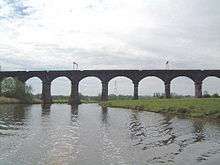Dutton Viaduct
| Dutton Viaduct | |
|---|---|
 Dutton Viaduct | |
| Coordinates | 53°16′59″N 2°37′43″W / 53.28294°N 2.628576°WCoordinates: 53°16′59″N 2°37′43″W / 53.28294°N 2.628576°W |
| Carries | West Coast Main Line |
| Crosses | River Weaver |
| Locale | Dutton, Cheshire |
| Heritage status | Grade II* listed |
| Characteristics | |
| Total length | 500 yards (457 m) |
| Clearance below | 60 feet (18 m) |
| History | |
| Opened | 1837 |
| Statistics | |
| Toll | None |
Dutton Viaduct is a railway viaduct on the West Coast Main Line where it crosses the River Weaver and the Weaver Navigation between the villages of Dutton and Acton Bridge in Cheshire, England (grid reference SJ581764), near Dutton Horse Bridge. It is recorded in the National Heritage List for England as a designated Grade II* listed building.[1]
The viaduct was built during 1836 and was completed on 9 December of that year. It was the longest viaduct on the Grand Junction Railway (GJR)[2] and is an early example of a major railway viaduct. Its cost was £54,440 (equivalent to £4,700,000 in 2016).[3] The engineers were Joseph Locke and George Stephenson.[1] The contractor was William Mackenzie. It was the first project for which Thomas Brassey submitted a tender but Mackenzie's estimate was £5,000 lower.[4] It is built in red sandstone and has 20 arches. The base of the viaduct pillars are splayed to give greater stability and 700,000 cubic feet (20,000 m3) of stone was used in its construction. The first GJR trains to carry passengers across the viaduct were run on 4 July 1837.[2] Steel masts were added in the 1960s for electrification.[1] The viaduct is 60 feet (18 m) high and 500 yards (457 m) long.[5]
The permitted speed on the viaduct is 125 miles per hour (200 km/h) and, because of limited trackside clearance, the viaduct is a 'red zone prohibited area', meaning that workers are not permitted on the line when trains are running unless separated by a permanent fence. A 'near miss' incident was recorded in September 2017 when line-side contractors carrying out a structural inspection on the viaduct crossed the tracks between obsolete refuges in breach of the red zone regulations.[6]
See also
References
- 1 2 3 Historic England, "Dutton Viaduct (1139139)", National Heritage List for England, retrieved 1 December 2012
- 1 2 Webster, Norman W. (1972), Britain's First Trunk Line, Adams & Dart, p. 86, ISBN 978-0239001054
- ↑ UK Retail Price Index inflation figures are based on data from Clark, Gregory (2017). "The Annual RPI and Average Earnings for Britain, 1209 to Present (New Series)". MeasuringWorth. Retrieved November 6, 2017.
- ↑ Walker, Charles (1969), Thomas Brassey, Railway Builder, London: Frederick Muller, p. 14, ISBN 0-584-10305-0
- ↑ The Grand Junction Railway, The Wolverhampton Exhibition of Commerce and Services, archived from the original on 10 July 2008, retrieved 25 November 2007
- ↑ "Near miss between a train and line-side workers on Dutton Viaduct, Cheshire, 18 September 2017". Rail Accident Investigation Branch. 4 December 2017. Retrieved 7 March 2018.